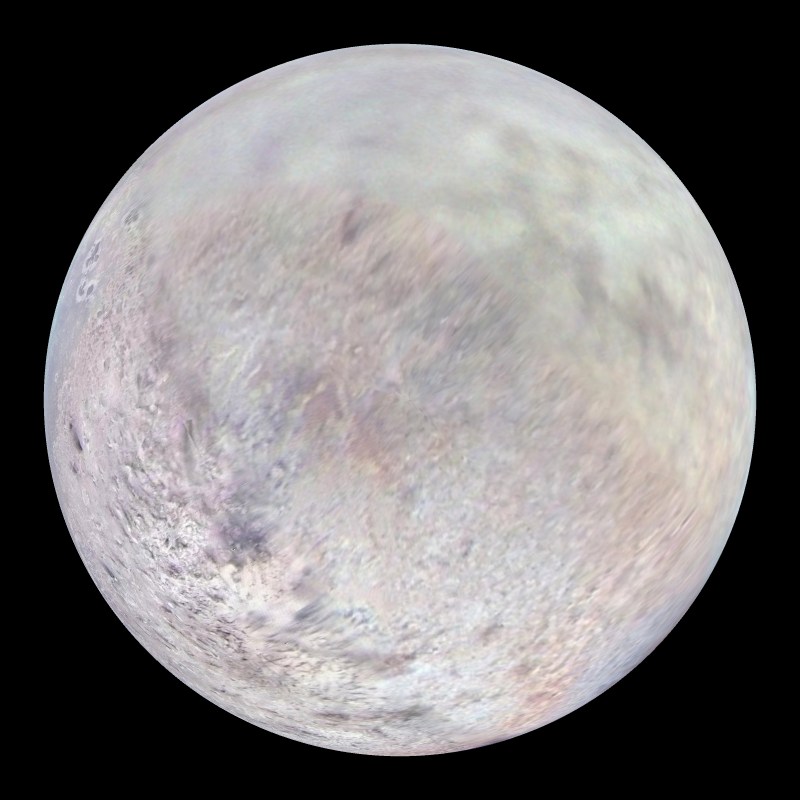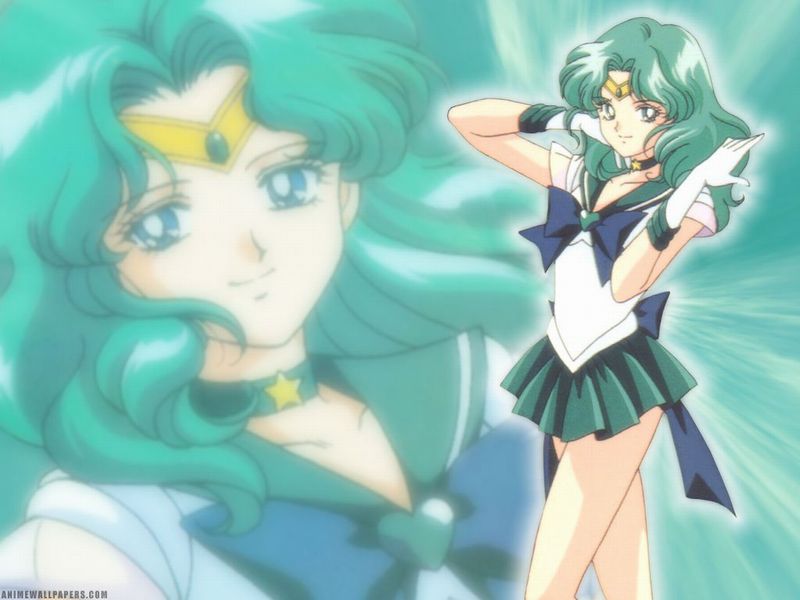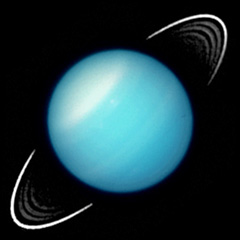Hello everyone! Welcome to my blog! Today we have a special guest it's Scientificmeap! Scientificmeap: uuuuuuggggg why did you make come all the way here its so much work is had to walk a yard to get here wwwaaahhh!!. Shut it! no one cares about your feelings! If you don't want to be here just leave! or better Security! Security! Get this lazy girl out of here!Now as i was saying today we are going to talk about Neptune.
The planet Neptune was mathematically predicted before it was discovered, by Urbain Le Verier, telescopic observations confirming the existence of a major planet were made on the night of September 23–24, 1846, at the Berlin Observatory,by Johann Gottfried Gall. Neptune was named after the roman god Neptune which is the god of the sea.
Neptune is different from the other gas giant planets because: Neptune is smaller then all the other gas giants, but it is similar to Uranus because it's atmosphere absorbs red light like Uranus that's Neptune has its pretty blue color. Neptune is similar to Jupiter because it has a great dark spot which is like Jupiter's red spot. Neptune is really similar to Uranus by color and size its only a little bit smaller. Unlike the other planets Neptune has a really long orbit around the sun it takes 164.79 years!. Also Neptune is the only planet to have a moon that orbits Neptune the opposite way Neptune spins.
Now we are going to talk some of Nepune's storms. First w are going to talk about the Great Dark Spot. The Great Dark Spot was a huge spinning storm in the southern atmosphere of Neptune which was about the size of the entire Earth. Winds in this storm were measured at speeds of up to 1,500 miles per hour. These were the strongest winds ever recorded on any planet in the solar system! Wow that's some really strong winds! The Great Dark Spot was first discovered when the Voyager 2 spacecraft flew by Neptune in 1989. When the Hubble Space Telescope looked at Neptune in 1994, the Great Dark Spot was gone and a different dark spot had appeared in the northern atmosphere of Neptune.
Neptune's Small Spot is The Small Dark Spot, sometimes also called Dark Spot 2 or The Wizard's Eye, was a southern cyclonic storm on the planet Neptune. It was the second most intensive storm on the planet in 1989, when Voyager 2 flew by the planet. When the Hubble Space Telescope observed Neptune in 1994, the storm had disappeared.
 The Storm nicknamed the Scooter is high level clouds that whip across the sky in the upper atmosphere.
The Storm nicknamed the Scooter is high level clouds that whip across the sky in the upper atmosphere.

It does snow on Neptune but it's not like snow on earth, it is of ammonia ice crystals. i
Neptune does have water because ice is present in the atmosphere of Neptune, which is comprised of water. Also, the interior of Neptune contains ice. Ice, and thus, water, can be found among the rock inside Neptune.
 Neptune has thirteen moons that we know of. The largest moon is Triton. Triton is slightly smaller than Earth's Moon and has active volcanoes which erupt like geysers and eject nitrogen frost over the surface.
Neptune has thirteen moons that we know of. The largest moon is Triton. Triton is slightly smaller than Earth's Moon and has active volcanoes which erupt like geysers and eject nitrogen frost over the surface.

Guess what time it is! Its fun fact time!!!!!! Yaaayyy!! cough cough I mean lets get started.
1) Neptune is the 8th planet in the solar system.
2) Neptune's largest moon is Triton
3) Neptune has a lot of strong storms.
Thank you for reading my blog! OK Scientificmeap you can leave now! Scientificmeap: YAAYYY!!! WOOO HOOO OH YEAH!! I mean ok sure thanks for letting me be on your blog.
 Link1
Link2
Link3
Link4
Link5
Link6
Link1
Link2
Link3
Link4
Link5
Link6
Hello everybody! Welcome to my blog. Today we are going to talk about the planet Uranus. Well.... here we go.
Uranus was discovered on March 30th 1781 by William Herschel. Uranus got its name from Uranus is named after the ancient Greek god of the sky, who was the father of Kronos.
Yes Uranus does has rings here are some facts about them: Uranus has 9 brighter rings as well as several fainter rings. Some of the larger rings are surrounded by belts of fine dust. The outermost ring is made up of ice boulders several feet across. The other rings are made up mainly of icy chunks darkened by rocks. The rings are thin, narrow, and dark compared to the rings of other planets.
Uranus has 27 moons that we know of. One of the bigger moons is Titania. Here is some information about Titania. Titania is Uranus's largest moon. A prominent system of large valleys, some nearly 1,000 miles long, are visible near the shadow line. The moon is about 1,600 km long in diameter.
Uranus is a giant ball of ice and gas so you can't really say that is has a surface If you tried to land a spacecraft on Uranus, it would just sink down through the upper atmosphere of hydrogen and helium, and into the liquid icy center. When you look at Uranus see the blue-green color that seems to come from the surface of Uranus. This color is light from the Sun reflected off Uranus’ surface. The atmosphere of Uranus contains hydrogen and helium, and most importantly, it has relatively large amounts of methane. This methane absorbs color in the red end of the spectrum of light, while photons at the blue end of the spectrum are able to reflect off the clouds and go back into space. So the full spectrum of the Sun’s light goes in, the red and orange end of the spectrum is absorbed, and the blue green end of the spectrum bounces back out. And this is why the surface of Uranus has its color.
 Uranus is different from the other planets because Uranus has a very weird axis rotation. because its axis of rotation is tilted sideways, nearly into the plane of its revolution about the Sun. Its north and south poles therefore lie where most other planets have their equators.
Uranus is different from the other planets because Uranus has a very weird axis rotation. because its axis of rotation is tilted sideways, nearly into the plane of its revolution about the Sun. Its north and south poles therefore lie where most other planets have their equators.
 Guess what time it is! It's Fun Fact Time! Here are some Fun Facts about Uranus!!!!!
Guess what time it is! It's Fun Fact Time! Here are some Fun Facts about Uranus!!!!!
1) Uranus is the 7th planet from the sun.
2) Uranus's largest moon is named Titania.
3) Uranus has 27 moons in total.
4) Uranus was discovered by William Herschel.
Thank you for reading my blog! This is Science Cat saying keep reading my blogs and have a very nice day.
 has one of the most unusual orbital characteristics in the solar system. In contrast to most other planets, Uranus's ax moving in a large circle, Uranus is more like a barrel, rolling on its side in a bigger circle. The cause of this peculiarity is unknown, but one theory presents it as being the result of a collision between a massive body sometime in ts past. Thus, with the planet's south pole pointing toward the , Uranus receives more solar input in that area than it does on the equator! However, an unusual fact is that the equator is still hotter than any other area of the planet, a phenomena that remains currently unexplained.
Link1
Link2
Link3
Link4
Link5
Link6
has one of the most unusual orbital characteristics in the solar system. In contrast to most other planets, Uranus's ax moving in a large circle, Uranus is more like a barrel, rolling on its side in a bigger circle. The cause of this peculiarity is unknown, but one theory presents it as being the result of a collision between a massive body sometime in ts past. Thus, with the planet's south pole pointing toward the , Uranus receives more solar input in that area than it does on the equator! However, an unusual fact is that the equator is still hotter than any other area of the planet, a phenomena that remains currently unexplained.
Link1
Link2
Link3
Link4
Link5
Link6














